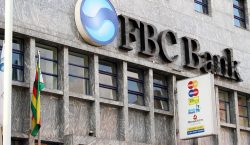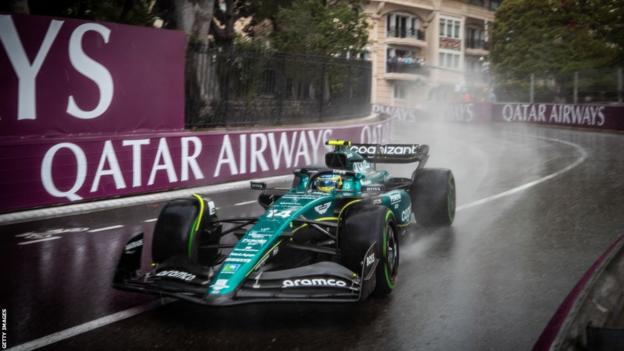

Fernando Alonso and Aston Martin could have won the Monaco Grand Prix. That is the conclusion offered by analysing the timing data around the crucial pit-stop period during which the race was hit by rain.
After the race, Aston Martin team principal Mike Krack said it had been a “misjudgement” to fit dry-weather medium-compound tyres to Alonso’s car when the Spaniard pitted at the end of lap 54.
Krack said the team would “play everything back”.
“The calls are made in a very short amount of time and then you have to live with it,” he said. “We will look into it, learn from it and try to do better next time.”
Leader Max Verstappen and his Red Bull team chose not to stop at the end of lap 54, and the world champion lost a lot of time as he slithered around on his worn medium tyres before pitting for treaded intermediate tyres at the end of lap 55.
The question in hindsight is: what would likely have happened had Alonso and Aston Martin fitted intermediate tyres at the end of lap 54 – as did Mercedes drivers George Russell and Lewis Hamilton, Alpine duo Esteban Ocon and Pierre Gasly, and Alpha Tauri’s Yuki Tsunoda?
First, some context. Conditions were changing rapidly, the rain steadily increasing and, as usual with Monaco weather, teams’ forecasts were not giving a clear picture.
Alonso was more than 24 seconds ahead of Russell, and well over 30 ahead of Ocon, Hamilton and Gasly. So the conditions he was experiencing as he came around to the pits on lap 54 would have been less wet than those of the cars behind him as the rain moved in.
“I asked about the forecast.” Alonso said. “They said: ‘There’s gonna be a short shower, we don’t know the quantity but it shouldn’t be not too heavy.’ I said: ‘We go for the dries, we go for dries.'”
Verstappen, in front of Alonso and on heavily worn mediums he had been using for twice as long as intended because he was delaying a stop waiting for rain, did not stop that lap.
Clearly, Alonso and Aston faced a difficult decision.
When Alonso made his stop on lap 54, he had made up more than five seconds on Verstappen in that one lap, and was eight seconds behind. Remember that number – eight seconds.
On lap 55, with the rain coming down increasingly heavily, Verstappen was struggling on worn slick tyres and even hit the wall at Portier before coming around to the pits to take on intermediate tyres. Alonso, having realised that the track was now much wetter, followed him in to do the same.
Behind, on their new intermediates, Ocon, Hamilton and Gasly all gained about seven or so seconds on the Red Bull just in the middle sector on that lap. Russell lost nearly four seconds, because he went up an escape road having been caught out by the conditions.
By the end of lap 55, Hamilton had gained 14.8secs on Verstappen, Ocon 12.2 and Gasly 5.2.
That makes it look as if it might have been touch and go for Alonso had he fitted inters on lap 54. Just looking at those gains, it suggests if he had driven at Hamilton’s pace, he would have made up more than the eight-second deficit he had before he came in. Had he driven at Ocon and Gasly’s pace, he would not.
But those numbers do not include Verstappen’s pit stop, and the time he would have lost coming out of the pits.
For those, as BBC 5 live analyst Jolyon Palmer observed, you need to look at lap 56.
Over the period from the end of lap 53 to the end of lap 56, Hamilton gained a net 20 seconds on Verstappen, Ocon a net 17 and Gasly a net 6.3.
Apply those numbers to Alonso, and he would have been well ahead of Verstappen if he fitted inters on lap 54 and drove at Hamilton’s or Ocon’s pace, which it is a reasonable assumption the two-time champion would have.
Those numbers only apply if the pace comparison between the drivers is relatively neutral on lap 56, and therefore the time offset is accounted for only by the pit stop and time gained on intermediate tyres on lap 55.
The only way to judge that is to look at the times for all the drivers over the second and third sectors of lap 56. They are the only things directly comparable because Verstappen’s first-sector time includes his pit-exit loss.
And the times for Verstappen, Ocon, Hamilton and Gasly over the rest of lap 56 are all pretty much the same. There are small differences – but nowhere near enough to cancel out the large gain overall.
So, yes, those differences between the end of laps 53 and 56 can reasonably fairly be used to judge what would likely have happened between Verstappen and Alonso had Aston Martin fitted intermediate tyres on lap 54.
Alonso would have been ahead – by a significant margin. Over the remaining laps, Verstappen would doubtless have caught him. But passing is all but impossible at Monaco, so Alonso would likely have won.

It is easy to say Alonso would have won in hindsight, of course.
When he pitted, the rain was not that heavy and he felt the track was still appropriate for slick tyres. Aston Martin were expecting a short, relatively light shower and that, as Krack put it, “the track would dry quickly because it was very hot”.
Alonso said: “We had huge margin behind to do two stops if needed, one for the dries and one extra for the inters and we thought it was the right thing.”
But that’s the thinking of a team more worried about securing second against those behind, not looking ahead.
From the point of view of trying to win the race, fitting a new set of slicks was a mistake.
When they pitted, Aston Martin could not have known what the right tyre would turn out to be.
If it turned out to be slicks, Verstappen would also have fitted them when he came in after Alonso and nothing would have changed. In that context, fitting slicks made no sense. The outcome was only ever going to be status quo in second place.
The only possible way to beat Verstappen was if inters were going to turn out to be the right choice on lap 54 – as indeed they were.
Judging by the numbers above, it does look as if Alonso would have had a strong chance to win had Aston Martin fitted intermediates at his first stop.
For Alonso and Aston Martin, this looks like a win that got away. – bbc.com